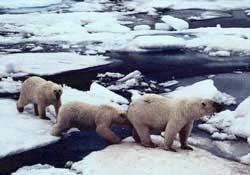The inevitable phenomenon of warming in the Arctic
 An international study by 120 scientists from 11 countries concluded that warming in the Arctic cannot be avoided and needs to be adapted to this.
An international study by 120 scientists from 11 countries concluded that warming in the Arctic cannot be avoided and needs to be adapted to this.
According to David Barber, a sea ice specialist at the University of Manitoba (Canada), the Arctic ice casing has melted at a rate of 74,000 square kilometers per year, an area equal to Lake Superior in North America and this has happened 30 years ago. The scientific community believes that the factors make the situation more serious and cannot be changed.
Louis Fortier, a scientist at Laval University (Canada), led the study, asserting that: ' To mitigate the negative impacts of climate change, we need to review our lifestyle from tomorrow. . We have to eliminate car use and reduce greenhouse gas emissions by 60 to 80%, but all of these things will be very difficult . '
According to Fortier, the Kyoto Protocol is just a small step in the right direction, as well as 'a baby starting to practice', but North America and Europe need to do 20 times better than the goal that Kyoto set out to change the situation.
Scientists participating in the large-scale research that began in 2002 met this week in Winnipeg to work together to produce research results.
- Abnormal melting ice alarm in the Arctic
- Unable to salvage the Arctic phenomenon
- Earth warms, the Arctic will explode vegetation
- 7 irreplaceable roles of the Arctic sea ice
- Warming in the Arctic will affect Vietnam
- Ice in the Arctic down to a record low
- For the first time in 100,000 years, the Arctic ice can melt completely
- The Arctic ice color is closely linked to climate change
- In 40 years the Arctic will run out of ice?
- What's going on with the Earth's 'refrigerator'?
- Vessels can cross the Arctic in 2050
- Arctic animals call for help
 Is the magnetic North Pole shift dangerous to humanity?
Is the magnetic North Pole shift dangerous to humanity? Washington legalizes the recycling of human bodies into fertilizer
Washington legalizes the recycling of human bodies into fertilizer Lightning stone - the mysterious guest
Lightning stone - the mysterious guest Stunned by the mysterious sunset, strange appearance
Stunned by the mysterious sunset, strange appearance